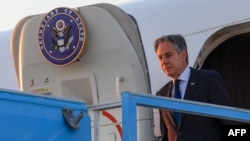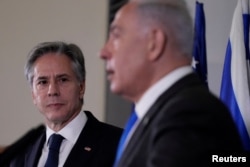U.S. Secretary of State Antony Blinken arrived in the Middle East hoping to broker an elusive cease-fire deal aimed at ending Israel’s devastating war in the Gaza Strip.
But the top U.S. diplomat left the region on August 21 -- his ninth visit during the 10-month-old war -- without securing any major breakthroughs.
Experts say key differences remain between Israel and EU- and U.S.-designated Palestinian terrorist group Hamas, the two sides in the conflict.
“This is still very much a work in progress, and I'm personally not optimistic,” said Firas Maksad, a senior fellow at the Middle East Institute in Washington.
'Sheen Of Optimism'
Ahead of Blinken’s latest visit, U.S. officials expressed optimism that a cease-fire deal was closer than ever.
He traveled to Israel, Egypt, and Qatar in a bid to inject urgency to secure an agreement. During his stay in Tel Aviv, he warned that this was “maybe the last opportunity” to secure a deal.
But Blinken appeared to be downbeat in comments he made as he ended his tour of the region.
Confidence had grown after Blinken met Israeli Prime Minister Benjamin Netanyahu and announced that Israel had accepted a U.S. "bridging proposal" aimed at narrowing the gaps between the two sides in the war. He then urged Hamas to do the same.
But just a day later, Netanyahu was quoted by Israeli media as disagreeing on a key sticking point -- the full withdrawal of Israeli troops from Gaza.
Hamas has not explicitly rejected the U.S. proposal, but said it went against previously agreed terms.
Washington has been keen to add urgency to the protracted cease-fire talks after Israel’s suspected assassinations of Ismail Haniyeh, the political leader of Hamas, in Iran and a senior Hizballah commander in Lebanon last month. Tehran, which backs Hamas and Hizballah, has vowed revenge, sparking fears of a wider regional war.
Maksad said the United States is putting a “sheen of optimism” on the talks to pressure Israel and Hamas into accepting the proposed cease-fire deal and to assure Iran and Hizballah that progress is being made.
The goal, Maksad added, is to prevent an Iranian-led attack on Israel and avert an all-out war in the volatile region.
Iran has so far delayed its retaliation against Israel and has suggested that it does not want its actions to impact cease-fire talks.
'War May Not Actually End'
Experts say it is not even clear if the two men central to the negotiations want peace -- Netanyahu and Hamas leader Yahya Sinwar, who has been blamed for masterminding the deadly October 7 attacks in Israel that triggered the war in Gaza.
Key members of Netanyahu’s right-wing coalition are opposed to a cease-fire deal.
“[Netanyahu] knows his coalition in the Knesset would be at risk if he signs a deal that ends the war,” said Michael Horowitz, head of intelligence at the Bahrain-based Le Beck International consultancy.
Meanwhile, Hamas may be waiting for an Iranian strike on Israel, “which would escalate regional tensions and may give the group more leverage in the future,” Horowitz added.
Maksad said that Sinwar from the onset of the war has “wanted to very much draw in Iran and its various proxies in support of his cause.”
What could potentially complicate matters further is the attempted suicide bombing in Tel Aviv on August 18, which Hamas claimed to have carried out in cooperation with the Palestinian Islamic Jihad extremist group.
Hamas renounced suicide attacks in 2006 before taking over in Gaza as it sought more legitimacy and international recognition. But the return of suicide operations could have consequences, according to experts.
“It suggests the war may not actually end, but may only morph into something more terrifying, more destructive, and ultimately more threatening both to Israeli security and the future hopes of a Palestinian state,” said Gregory Brew, a senior analyst at the U.S.-based Eurasia Group.
Deal's Sticking Points
Specific details of the U.S. cease-fire proposal have been kept under wraps, but analysts say it envisions a multiphase deal.
Horowitz said the first phase would include a gradual withdrawal of Israeli troops from most of Gaza and the release of some of the scores of Israeli hostages held by Hamas in return for Palestinian prisoners.
Negotiations would also be held to facilitate a permanent cease-fire during the second phase.
“Hamas is concerned that, even if it signs the U.S. bridging proposal, talks for a permanent cease-fire between phase 1 and phase 2 will fail, and Israel will use this as an excuse to resume the war,” he said.
Horowitz said that Netanyahu wants to retain the right to decide which Palestinian detainees are released in the prisoner exchange. Crucially, he added, Netanyahu also wants the Israel Defense Forces (IDF) to maintain a presence along at least one of two strategic corridors in the Gaza Strip.
The Philadelphi corridor is a narrow strip of land running along the enclave’s southern border with Egypt. The Netzarim corridor, which runs just south of Gaza City, divides the territory into southern and northern sections.
“Hamas's main objective is to secure a permanent end to the war and the full withdrawal of all IDF troops -- to that end, accepting Israel's right to keep troops inside the territory is unacceptable,” said Brew.
He added that “without Israeli concessions on Philadelphi or Netzarim -- or, less likely, a full Hamas retreat from the issue -- a deal doesn't look likely.”

